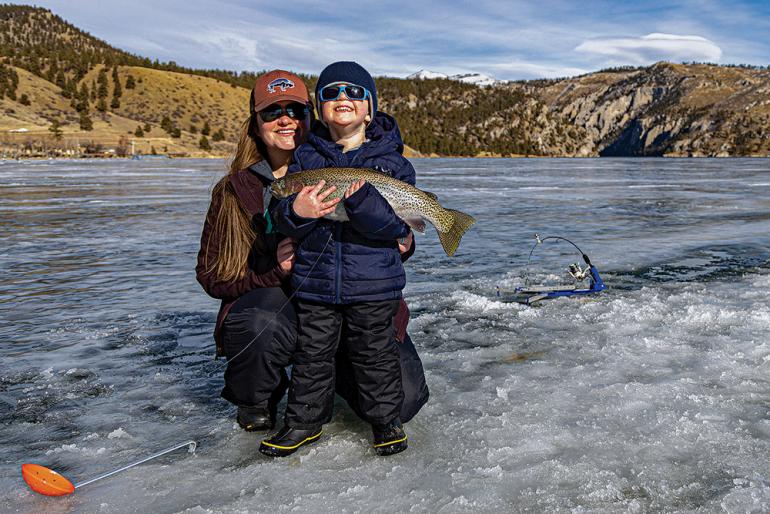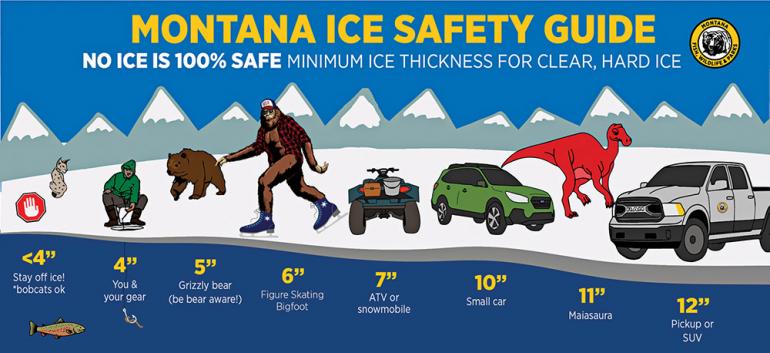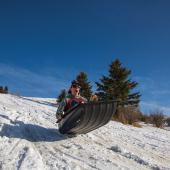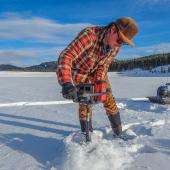Walking on Water
A primer on ice fishing.
Do you own a fishing boat? That’s okay, neither do I. Which is why I love winter: ice puts anglers on equal footing. It gives shore-bound fishermen a shot at reaching places where only our imaginations could go the rest of the year. And the thrill of hovering over a twitching rod, then pulling a wriggling trout out of a hole in the ice, makes you feel like you’re walking on water.
Ice fishing is amiable to the novice and budget-minded angler. Sure, you can still outfit yourself with any amount of gear and technology that fits your style. But if you’re just getting started, chances are you already have most of what you need. Here are a few tips.
Safety
It’s important to know when the ice is safe. Generally, four inches of solid, clear ice is the minimum for walking on, but thicker is better. Ice conditions can change rapidly, especially on small ponds, so keep an eye on daily temperatures. If no one else is fishing, it may be because the ice is too thin. It’s also good practice to go with a group of people and wear a life jacket. Fishing forums and social media pages can be good places to get fishing reports and ice updates.
Equipment
What you wear is important, starting with your feet. Ice sometimes forms in hollow layers, creating slush and water pockets several inches deep. Wear waterproof boots and bring extra socks. Snow pants and coveralls work well at repelling water and keeping the wind out. Don’t forget thermal layers, plus a coat, hat, gloves, and sunglasses. Avoid wearing cotton.
Ice fishing rods are cheap, but regular spinning rods will do the job. Light fishing line between four- and eight-pound test works well. You’ll need a skimmer for scooping ice and snow out of your fishing hole.
Like boats, ice augers can be pricey, but they open portals of opportunity. If you don’t have an auger, there are a few workarounds. Compliment your friends or relatives on theirs, and they might offer a loan. Sometimes you can chisel open a hole that someone drilled recently. And there’s no harm in asking for help on the ice. Ice anglers are generally social and friendly, and the worst they can say is “no.”
Tackle & Fishing
Ice-fishing tackle is simple: a plain hook with bait, a sinker, and a bobber may be all you need. You can also try spoons, small jigs, or soft plastics tipped with bait. Maggots, worms, and corn are effective baits. Check the regulations, available at local fishing shops and fwp.mt.gov, to find out what’s legal where you’re fishing.
Trout and perch are the most popular targets for ice anglers. Trout can be at any depth, while perch are usually within one or two feet of the bottom. If you’re being patient and not getting bites, try changing the depth of your lure.
Some local ice-fishing hotspots include Hyalite Reservoir, Harrison Lake, Canyon Ferry, Ruby River Reservoir, Clark Canyon, Hebgen Lake, and the Bozeman ponds.
Morgan Jacobsen is the public information officer for Montana Fish, Wildlife & Parks.














